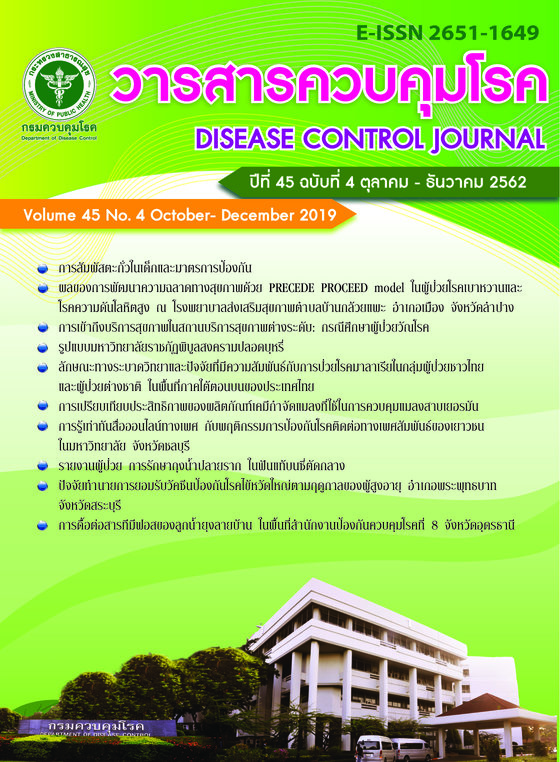Accessibility of health care service in different health care settings: a case study of tuberculosis patients
DOI:
https://doi.org/10.14456/dcj.2019.33Keywords:
patients with tuberculosis, health service accessibility, availability, affordability, acceptability, different health care settingsAbstract
Tuberculosis (TB) continues to be an important public health problem in Thailand. Thailand is classified by the World Health Organization (WHO) as one of the 14 countries in the world with the highest TB burden. Despite advances in tuberculosis and AIDS treatment to the extent that morbidity and mortality rates from tuberculosis and AIDS have significantly been reduced, the challenges still remain as evidenced by a delay to recruit TB patients into the existing TB treatment and management system, thus potentially leading to mortality among tuberculosis patients. Objectives: This study aimed to determine and compare the accessibility of patients with tuberculosis to health care services in different health care settings in terms of availability, affordability, and acceptability. Method: This study used a descriptive cross-sectional design. The data were collected from 120 patients with tuberculosis who registered in four different health care settings, i.e. community hospital, general hospital, private hospital, and office of disease prevention and control, during October 2017 - January 2018. A questionnaire was used to collect the three-dimension data of availability (7 items), affordability (7 items), and acceptability (6 items). The data were analyzed using descriptive statistics. Kruskal-Wallis test was used to compare the mean score of accessibility among four different health care settings. Results: There were 22 (18.33%) patients with tuberculosis participating in setting A; 79 patients (65.83%) were from setting B; 5 patients (4.17%) were from setting C; and 14 patients (11.67%) were from setting D. It was found that acceptability dimension had a highly satisfactory level (x ̅ = 4.29±0.60), followed by availability dimension with a moderately satisfactory level (x ̅ = 3.84±0.66), and affordability dimension with an unsatisfactory level (x ̅ = 2.86±0.86). In addition, levels of accessibility showed statistically significant difference among 4 health care settings for availability and affordability dimensions (p<0.05), but there was no difference among 4 health care settings in terms of acceptability dimension. Conclusion: Overall, of the three dimensions of accessibility, patients’ acceptance toward healthcare providers is the most important dimension, followed by availability dimension. Affordability is the least significant dimension on the accessibility of patients with tuberculosis to health care settings. To increase TB patients’ accessibility to health care services, it is important that both patients and healthcare providers build a mutually positive relationship. Health facilities should have in place an efficient service delivery system in terms of facilities, manpower, medicines, and turnaround time, while encouraging more active engagement from various organizations in the community in order to assist the patients with extra expenses in addition to medical bills.
References
2. Bureau of Tuberculosis, Department of Disease Control. National tuberculosis control programme guideline, Thailand, 2018. Nonthaburi: Bureau of Tuberculosis, Department of Disease Control; 2018. (in Thai)
3. Arakawa T, Arcêncio RA, Scatolin BE, Scatena LM, Ruffino-Netto A, Villa TCS. Accessibility to tuberculosis treatment: assessment of health service performance. Rev Latino-Am Enfermagem 2011;19:994-1002.
4. Arcêncio RA, Arakawa T, Oliveira MF, Cardozo-Gonzales RI, Scatena LM, Ruffino-Netto A, et al. Financial challenges to access tuberculosis treatment in Ribeirão Preto-São Paulo. Rev esc enferm USP 2011;45:1121-7.
5. Dangisso MH, Datiko DG, Lindtjørn B. Accessibility to tuberculosis control services and tuberculosis programme performance in southern Ethiopia. Glob Health Action 2015;8:10.3402/gha.v8.29443.
6. Grut L, Sanudi L, Braathen SH, Jürgens T, Eide AH. Access to tuberculosis services for individuals with disability in Rural Malawi, a Qualitative Study. PLoS One 2015;10:e0122748.
7. Rodrigues AM, Scatena LM, Vendramini SH, Canini SR, Villa TC, Gir E. Assessment of tuberculosis treatment accessibility for patients co-infected or not with the human immunodeficiency virus. Rev Esc Enferm USP 2012;46:1163-9.
8. Wang W, Jiang Q, Abdullah AS, Xu B. Barriers in accessing to tuberculosis care among non-residents in Shanghai: a descriptive study of delays in diagnosis. Eur J Public Health 2007;17:419-23.
9. Falkingham J. Poverty, out-of-pocket payments and access to health care: evidence from Tajikistan. Soc Sci Med 2004;58:247-58.
10. Penchansky R, Thomas JW. The concept of access: definition and relationship to consumer satisfaction. Med Care 1981;19:127-40.
11. Oliver A, Mossialos E. Equity of access to health care: outlining the foundations for action. J Epidemiolo Community Health 2004;58:655-8.
12. Wang F, Luo W. Assessing spatial and nonspatial factors for healthcare access: towards an integrated approach to defining health professional shortage areas. Health Place 2005;11:131-46.
13. McIntyre DI, Thiede M, Birch S. Access as a policy-relevant concept in low- and middle-income countries. Health Econ Policy Law 2009;4:179-93.
14. Finkelstein MM. Do factors other than need determine utilization of physicians' services in Ontario?. Can Med Assoc J 2001;165:565-70.
15. Chaimay B. Sample size determination in descriptive study in public health. Thaksin University Journal 2013;16:9-18. (in Thai)
16. Chidchanok R. Yongyut R. Dujrudee C. Chayutthaphong C. Basic data analysis for pharmaceutical research. Clinical pharmacy workshop; 2017 Mar 1-3; The Imperial Mae Ping Hotel, Chiang Mai. Chiang Mai: Faculty of Pharmacy, Chiang Mai University; 2017. (in Thai)
17. Xu B, Jiang QW, Xiu Y, Diwan VK. Diagnostic delays in access to tuberculosis care in counties with or without the National Tuberculosis Control Programme in rural China. Int J Tuberc and Lung Dis 2005;9:784-90.
18. Barnabishvili M, Ulrichs T, Waldherr R. Role of acceptability barriers in delayed diagnosis of tuberculosis: literature review from high burden countries. Acta Trop 2016;161:106-13
Downloads
Published
How to Cite
Issue
Section
License
Articles published in the Disease Control Journal are considered as academic work, research or analysis of the personal opinion of the authors, not the opinion of the Thailand Department of Disease Control or editorial team. The authors must be responsible for their articles.



.png)



